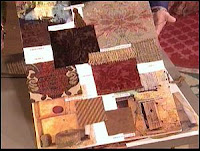
"When all of your ideas are placed on a design board, visually, you will be able to sense what is creating drama and what is not working. Introducing new ideas is much easier and the process will start to flow."
I've been interested in how designers present their conceptual ideas to clients (planning teams, stafff, etc). Most of these have come from watching these presentations on TV. Theirs are usually large project boards ( kind of reminds me of the BOOK REPORT boards we used to have to do in 4th grade) which contain drawings, samples and conceptual drawings of the room, project or design.
After the presentation the client lives by that board for the duration of the project. We did that when we built a church facility. Every paint sample, every carpet sample and every wall covering was on that board. When we had a question, we went back to the story board to make sure everything stayed together with the story the design had written. It doesn't always have to be large.
How about creating a story board on index cards--punch a hole in the top of the card and put a sample of the concept on each card. How about a piece of peg board or insulation foam? Cork board or ceiling tile works well too.


I don't always do that when we concept a series, but I keep a 12X18 piece of insulation foam in my office which works great for short presentations. I usually cover it with a material we are going to use for the series, a paint color or graphic. Then I begin tacking on the other elements that may be included in the services (pictures of media, lists of songs, etc).
When you put together a story board remember to collect items related to your series or concept:
1) Graphics
2) Paint chips (I'm continually picking up these chips at Lowes or WalMart)
3) Pictures of facilities
4) Notes about the services
5) Publications/ samples
6) Other items (things you might give away during the service or as a reminder during the service)








0 comments:
Post a Comment